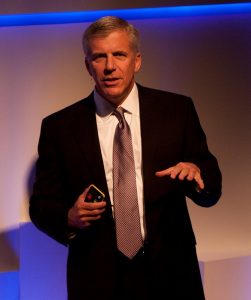
What if you could rank where you stand versus your industry peers when it comes to how effectively you're making use of your data through analytics? Now you can.
Jim Davis, Senior Vice President and Chief Marketing Officer at SAS, outlined an eight-metric test at today’s Premier Business Leadership Series in London. He explained how organisations are now asking themselves, “How can I enter new markets or even create new markets using company data?”
To achieve this you can measure your organization using the eight metrics set out below, and identify those areas that need addressing given how your industry, as a whole, compares. Only then can you move forward with extracting more value from your data through analytics, and forge ahead of the competition.
The eight metrics are:
- ROI -- Return on investment needs to be clear and agreed up front. For example, "we plan to reduce customer churn as a result of this investment by 50 per cent."
- Governance -- This relates to data and model stewardship. An organisation must not just look to IT to build its data warehouse. Everyone in the organisation needs to be part of the process and understand the value of data and how to improve the quality of data.
- Productivity -- The efficiency of processes supporting the analytics lifecycle is key here. This can be constantly refined over time. It starts off with a business problem, and what data is available to solve it. It then moves to data preparation and exploring data, so you can visualise it and see patterns. You then build models and deploy these models in the business – e.g., it could be something deployed in a call centre environment. You then evaluate and monitor the results. On a day-to-day basis it helps to have a service available that you can call on – like a helpdesk for IT issues, but dealing instead with data and analytics. Perhaps it should be seen as more of an “analytics centre of excellence” that acts like a repository of best practices.
- Timeliness -- The value from analytics needs to be realised in the available time window. For example, a large retailer in the US had SKUs for each product it sold. For stock-keeping purposes this amounted to 400 million combinations, yet the retailer wanted to be able to re-price products on a monthly basis. Using analytics it became possible to do this in a very short space of time using in-memory processing.
- Accuracy -- Data must be accurate first, for it to deliver any sort of impact in the analytics lifecycle.
- Effectiveness -- An organisation must be able to overcome challenges. This means all employees working together to make things happen, rather than working alone in siloes.
- Empowerment -- There must be a level of self-sufficiency supporting the analytics lifecycle. IT are key but it’s important to involve other parts of the organisation. There needs to be a willingness to embrace technology and fact-based decision-making. Staff need to be kept up-to-date on the latest technology and developments in their area.
- Maturity -- This relates to an organisation’s analytical competency, consistency and alignment across people, processes, technology, data and culture.
SAS has conducted a benchmark survey of more than 400 US companies across all industries to determine each organisation’s proficiency across the key metrics. The results of this survey are presented in the paper, Assessing Your Business Analytics Initiatives, to provide guidance for short- and long-term efforts needed to enhance analytical effectiveness.
Read the paper or use the Business Analytics Assessment to see how your organization measures up against the industry as a whole ineach of the eight metrics.
Why not investigate and find out where your business needs to focus to become more competitive?
